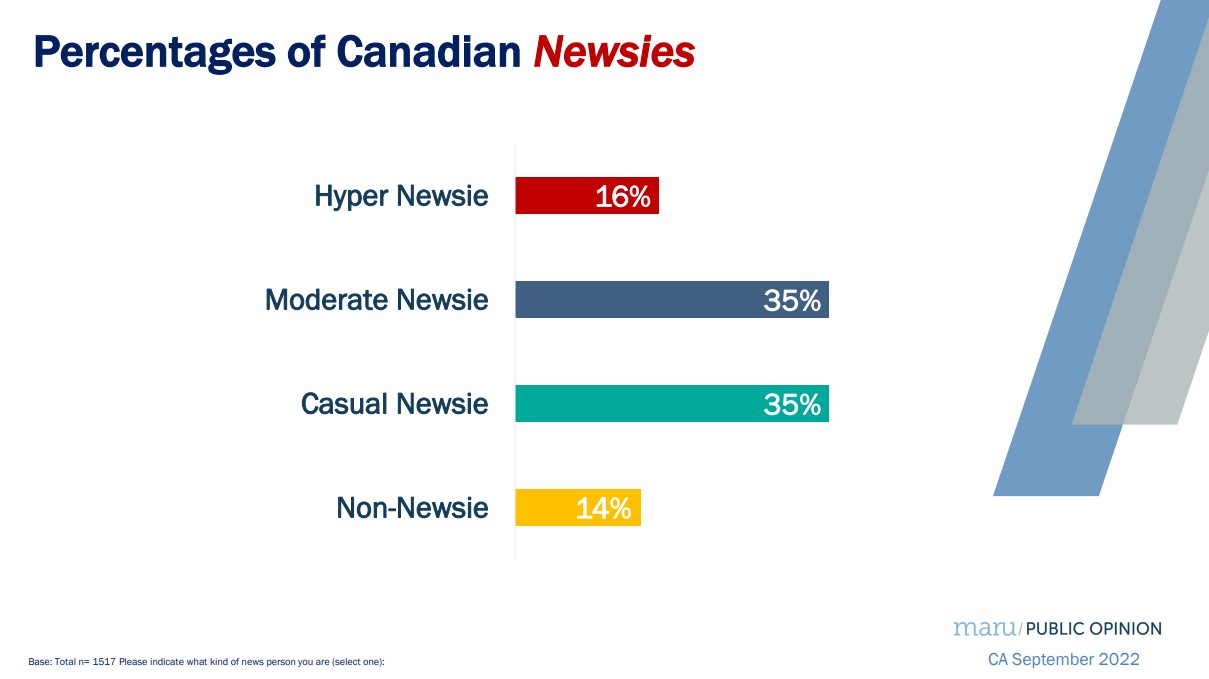Majority of Canadians get their news from mainstream sources, study shows

Posted September 28, 2022 6:25 am.
A new study shows that mainstream media sources still dominate where Canadians consume daily news but vary significantly by age group.
A Maru Public Opinion survey released on Wednesday found that of 1,517 Canadian adults who were polled and who check the news daily, 45 per cent of them said they get their updates from an evening TV newscast or late broadcast.
This was followed by a newspaper website (29 per cent), a TV news website (29 per cent), a TV station dedicated to business news and information (29 per cent), social media sites like Facebook or Instagram (26 per cent) and radio news broadcasts (24 per cent).
Of those polled, 14 per cent of respondents said they got their news from Twitter, which ranked 11th of 23 daily consulted news sources that were measured in the survey.
The results were released in coordination with World News Day 2022 — a global campaign to amplify the power and impact of fact-based journalism.
Here are the outcomes by age group, according to Maru Public Opinion.
Aged 18-34 (82% consume news daily):
- On social media sites like Facebook or Instagram, 35%
- TV news websites, 30%
- Newspaper websites, 24%
- Twitter, 23%
- Regular newscast on a TV station for either evening or late broadcast, 21%
- Tik Tok, 20%
- News Alerts like Google or Financial/Stocks, 17%
Aged 35-54 (82% consume news daily):
- Regular newscast on a TV station for either evening or late broadcast, 36%
- Newspaper websites, 35%
- TV news websites, 32%
- TV stations dedicated to only business news and information, 29%
- On social media sites like Facebook or Instagram, 27%
- Radio news broadcasts, 22%
- News Alerts like Google or Financial/Stocks, 17%
Aged 55-plus (93% consume news daily):
- Regular newscast on a TV station for either evening or late broadcast, 67%
- TV stations dedicated to only business news and information, 39%
- Radio news broadcasts, 32%
- In a daily newspaper you would typically pay for or subscribe to, 29%
- Newspaper website, 29%
- Community newspaper, 26%
- TV news websites, 26%

Survey results courtesy of Maru Public Opinion.
Per the Maru Public Opinion poll, hyper Canadian newsies are those who constantly check the news and use various sources. In contrast, moderate and casual Canadian newsies check their news sources a few times a day or only when interested.
Poll results show that many people now get news from social media sites and networks, which have increased censorship over the years, primarily due to misinformation and hateful speech.
One notable example of a social media platform cracking down on misinformation was when Twitter permanently banned former U.S. President Donald Trump days after the U.S. Capitol attack on January 6, 2021.
A recent case involved U.S. media personality Andrew Tate, who was banned from Instagram for sharing misogynistic and controversial views to 4.7 million followers. Tate was subsequently barred from Facebook for violating the platform’s policies on hate speech and dangerous organizations.
TikTok, where videos featuring Tate’s name as a hashtag had over 13 billion views, also removed his account. YouTube followed suit, banning Tate for spreading misinformation on COVID-19.










